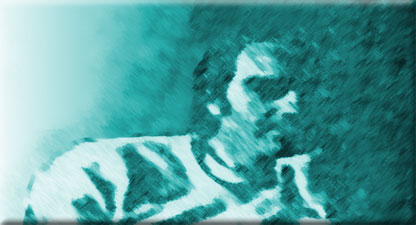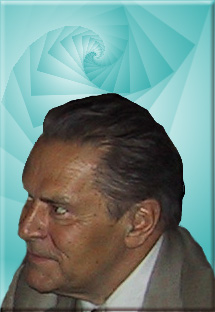 I once had a startling vision of death while contemplating the space between my breathing's inhale and exhale. Not long after that I attended an eight day workshop with Leonard Orr, founder of the Rebirthing movement. Leonard studied Prana yoga, and in the early seventies developed a Western version that was so simple and "effective" that it became a movement that launched a thousand practitioners, probably more.
I once had a startling vision of death while contemplating the space between my breathing's inhale and exhale. Not long after that I attended an eight day workshop with Leonard Orr, founder of the Rebirthing movement. Leonard studied Prana yoga, and in the early seventies developed a Western version that was so simple and "effective" that it became a movement that launched a thousand practitioners, probably more.
Most of us did something similar as kids, hyperventilation until the face turns red, the extremities tingle, and the backyard begins to spin. As Leonard says with an affable grin, "How to get high in 30 seconds." Leonard's technique is of course more refined, but the effect is familiar. He calls it Rebirthing in part because of breathing's importance at birth. Relearning how to breathe he believes is critical because birth for most of us is a traumatic experience and we ever after associate breathing (or not) with this trauma, and then by association with other traumas. Also, most people seem to recall vivid memories of their birth at some point in their early Rebirthing sessions (yes yes yes I'm mindful of hypnotherapy's "recall" as I write this).
Leonard doesn't care at all if I give away the technique. The client lays down comfortably and breathes in an easy connected rhythm. "Connected" means leaving no space between the inhale and exhale, and then the exhale and inhale. This is a little tricky for most people to master at first, but it comes pretty quickly. Leonard says it's a matter of learning from your breath how to breathe. I agree. You put your only muscle effort into the inhale, and just let the exhale happen. Watch any mammal while they're sleeping. The practitioner's job is to just sit there and gently remind you if you're messing up the rhythm. The skill of the practitioner lies in intuitively allowing for an individual's session to move in whatever direction seems appropriate for them. A typical session lasts for an hour or two. Most people get the expected hyperventilation sensations, but they usually subside after some time, and a variety of other things can happen. In my sessions I had a fair amount of tetany (fingers and toes numb) but even though this freaks out some, I thoroughly enjoyed all the body sensations. Also, free association led me to a lot of powerful realizations about myself, spurred on by discussions the small workshop group had about trauma, personality, habits, etc. In the early years Leonard started the practice with people Rebirthing in hot water (hot tub or bath), but he found the experience too strong for beginners. He now suggests 10 dry sessions before going wet. I understand this as I've done one session in hot water and the effect was dramatically stronger. With nose plug and snorkel, I quickly curled into fetal position and soon was gone from normal consciousness. Prana yoga has proven to be a powerful journey for me.
Leonard says one of the biggest problems he's had is with Rebirthing practitioners feeling guilty with how little they are actually doing for the money (they charge $40 to $80 for a session) and so they often add unnecessary prattle, massage, music or other effects just to make themselves feel more like experts. The Rebirthing movement is quite large (check any search engine). I believe it's the Danish health care system, he said, that built in payment for both the practitioner and the client for their time to do sessions. Leonard launched the movement and encourages people to re-train with him periodically. He readily admits he does this for the income, but also because he's refining the technique and it's corresponding philosophy as time goes on and would like to have a positive influence on his baby.
I think it's a good idea to do sessions with an experienced Rebirther in the beginning, as I've seen a variety of reactions, and an experienced guide in this trip can easily be called part of proper Set and Setting. However, after my first session, and watching a few others, I quickly got the hang of it and after the workshop I gave a session to my lover. She's since done the same for me. It's been beneficial, leaving us royally buzzed and blown away by the process as well as the corresponding physical benefits and cognitive expansion.

Leonard Orr
The writing above went out as an e-mail.
Several folks wrote back. Here are a few of the responses,
starting with a letter from my favorite philosohper, Robert Anton Wilson:
I've never tried the Orr method but had Rechian therapy c 1959. Seems similar, not identical. The therapist keeps you at it until you experience a "streaming" energy flow (the "orgone.") They also encourage "abreaction" [emotional expression of griefs, rages, "forbidden" emotions,etc.] all of which seem painful at first but fade out as you achieve better, more relaxed breathing. They combine this with muscular relaxation, similar but not identical with Rolfing.
After the Inquisition stopped his LSD research, Dr Stan Grof invented another breathing therapy, but I know little about it.
I still use Hindu prana-yama breathing when overwhelmed by depression or anxiety. Seems to banish them more and more easily as years pass.
--bob
And then Paul wrote:
Stanislav Grof's Holotropic Breathworks, aka Grof Breathing, seems to me to be identical with Rebirthing. The reported effects are very similar too.
There is a section in Michael Hutchison's 'Megabrain Power' dealing with Grof's method, which Hutchison says is potentiated by mind technologies. He recommends that you don't try this on your own, not just because there is a tendency to forget to breathe continuously when you begin to enter an altered state, but because some people's experiences can be quite alarming. Choking and convulsions occur, though rarely, and it is possible to get stuck in unpleasant material emerging from the unconscious. A guide can prevent you from hurting yourself, and help to encourage you to keep breathing through such experiences.
I have some limited experience with Grof's method, and have found that any unpleasant emotions, thoughts and feelings that emerge are best dealt with by continuing to breathe and relaxing the body. It feels to me as if pain and fear are not sensations in themselves, but a resistance to feeling, or an attempt to block the flow of energies in the body. I visualise my body as a tube with energy flowing through it, and any tensions as a constriction in the tube, leading to discomfort as the flow of energy is impeded. Works for me.
This could be related to imprinting in the first "approach/flee" circuit (in the Leary/Wilson model), leading to an automatic withdrawal from unpleasant feelings, using muscular armouring and shallow breathing (or even holding the breath). The trick in Grof Breathing is to overcome the automatic tendency to tighten up and stop breathing when unpleasant material emerges. I suspect that such breathing techniques could be thought of as methods for reimprinting the First Circuit.
On a physiological level, I think it's the rise in blood pH, as CO2 levels drop, that is supposed to lead to the effects reported, rather than an increase in blood oxygen. I know that such changes can affect the vagus nerves (remember the information on polyvagal theory Shava posted here a while back? -physical evidence of energy centers that correspond to the Chakra system - ed.), and I wonder if there is a connection. Many esoteric techniques consist of efforts to gain conscious control over the autonomic nervous system, which is the vagus nerve's domain.

Stanislav Grof
Pranayama seems to me to be different from Rebirthing, Grof Breathing or Reichian therapy. The former stresses the pause between inhale and exhale, whereas the latter eliminate it, which results in different physiological effects. In 'The Function of the Orgasm' Reich says "The breathing technique taught by Yogas [sic] is the exact opposite of the breathing technique we use to reactivate the vegetative emotional excitations in our patients. The aim of the Yoga breathing exercise is to combat affective impulses; its aim is to obtain peace." I am also struck by the difference between the abdominal/diaphragmatic breathing recommended in pranayama, and the chest breathing recommended by Reich.
Paul H
And then Phil wrote:
I've never explored rebirthing either, but have practiced pranayama since I was 11 years old. Also, more recently, I've been learning aikido, which has a very interesting body of breathing exercises, and use of breath in the techniques.
Use of the breath seems to me an important aspect of exploring consciousness. The breath normally functions unconsciously, is regulated outside of conscious awareness and only usually only impinges on awareness when there is some difficulty or change in the rhythm. In practicing pranayama or another breathing exercise, it seems to me that one reverses the normal direction of the relationship between conscious and unconscious. You begin to exert some conscious attention or control on your own body/mind unconscious processes. This creates both a metaphor for access to the unconscious and a definite physiological/neurological change. Other normally autonomous functions -- heartbeat, etc. -- are not so easily accessed.
Phil
return to top






